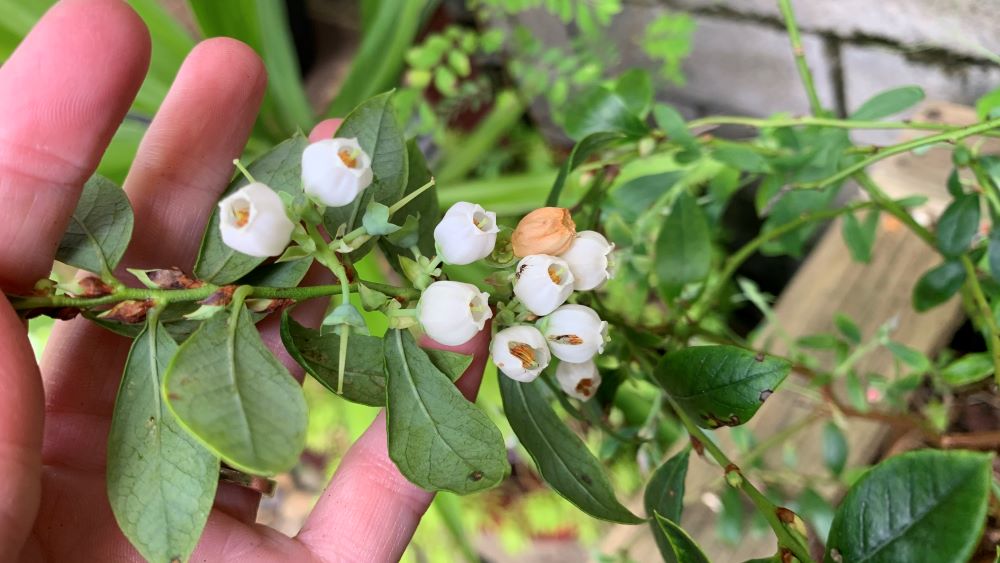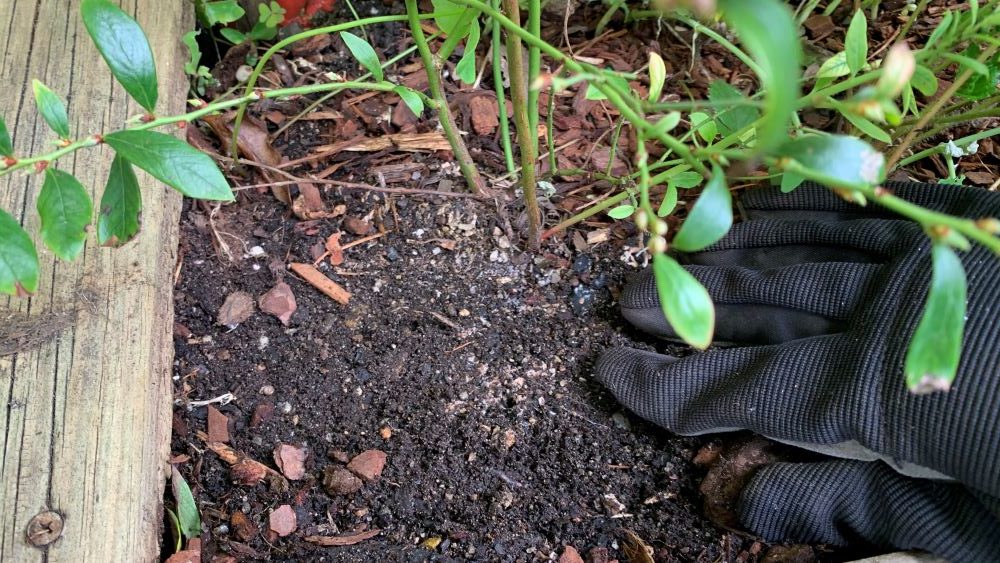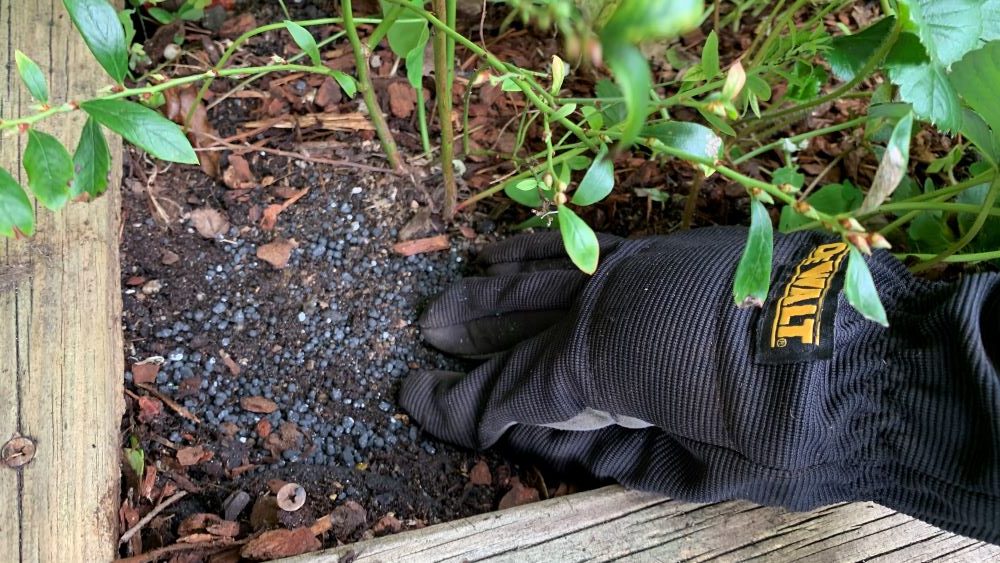Citrus fertilizer can be good for blueberries if they contain nitrogen in the form of ammonia which helps to increase the acidity of the soil over time and will promote growth. If your citrus fertilizer contains nitrogen in the form of nitrates this can decrease blueberry growth and fruit production over time.
Use citrus fertilizer on blueberries sparingly or as a one of dose if it does not specifically list blueberries on the label. Some citrus fertilizers will be perfect for blueberries. Check the nutrient list and look out for nitrogen in the form of urea or ammonia.

For blueberry bushes it is best to choose a blueberry or Azalea fertilizer which has nitrogen in the form of urea or ammonium sulfate and will decrease the pH of the soil over time. This is great for acid loving plants like blueberries and will give you beautiful blooms and lots of fruit.
This article will explore why citrus fertilizer should be used sparingly on blueberries, the best fertilizer choices and how to apply the fertilizer affectively.
This post may contain affiliate links. If you click one of these links and make a purchase, I may earn a commission at no additional cost to you. In addition, as an Amazon Associate I earn from qualifying purchases.
Citrus fertilizer for blueberries
Blueberries will thrive with a fertilizer around a 10-5-5 ratio of nitrogen, phosphorus and potassium. If you soil is already higher in nitrogen, the Nitrogen ratio can be lower. Citrus fertilizers tend to be lower in potassium and higher in nitrogen than one specific for blueberries.
Blueberries need fertilizer that decreases the pH, increasing the acidity of the soil aiming for a pH of around 4.5-5.5. This is achieved by choosing a fertilizer higher in nitrogen. They grow best with nitrogen in the form of ammonia, ie. Urea or ammonium sulfate.

You may also need to add an acidifying agent to decrease the soil pH further. Test your soil and start adjusting the pH down gradually each year after the plant has been in soil for 12 months. This is usually done with a Sulphur additive made specifically for soil.
Check out this simple soil acidifier here on Amazon.

Lookout for a slow release fertilizer to feed your blueberries. This will slowly deliver nitrogen to encourage good growth, phosphorus for good fruit and flower development as well as slowly decreasing the pH of the soil over time.
Best fertilizer for blueberries
Blueberries will thrive on a specialized fertilizer including one that is made for acid loving plants. This includes a blueberry fertilizer or azalea and rhododendron fertilizer.
Check out blueberry fertilizers here on Amazon here.

How to fertilize blueberries
Fertilizing blueberries is simple if you follow these easy steps. Blueberries love a feed at the start of the growing season in spring once the weather has warmed and the new growth has started to appear. Check out these easy steps to fertilize your blueberries at home.
1. Gently rake back the mulch
Start by gently raking back the mulch from around your blueberry bush. Gently pull the mulch back exposing the soil but not digging the rake back into the soil to touch the roots. Pull the mulch back as far at the outer leaf edge of the blueberry bush. This will mirror the outer edges of the root system.

2. Scatter fertilizer evenly on the soil
Wearing gloves, scatter the blueberry fertilizer around the root zone onto the soil. Gently sprinkle it around evenly to cover the area of exposed roots. Take care to do this gently and wear a mask if the fertilizer is granular and enters the air.
I like to choose an organic fertilizer if I can. This keeps it all natural in my garden.

3. Keep it off the leaves
When adding fertilizer to blueberries take care to only sprinkle it around the root zone and not on the leaves or stems. Some fertilizers can burn the leaves once the sun arrives. If you do accidentally get some fertilizer on the leaves, wash it off straight away with your hose with a sprayer attachment.

6. Cover it with mulch
Cover the root zone and blueberry fertilizer back over with 2-3 inches of mulch. Take the opportunity to add a fresh layer of mulch for spring. I like to choose sugar cane mulch or straw as it breaks down into the soil to add extra organic matter.
You can also use bark mulch which will break down slower. This is perfect if you have your blueberry bush planted in your garden bed with perennial flowers and shrubs.
5. Water it in well
The next step is to water the fertilizer in thoroughly. I like to use my hose with a sprayer attachment to water the plant thoroughly. Take the time to water the whole surface of the mulch to hold it down and to start to release the nutrients into the soil.
When to fertilize blueberry plants
Add fertilizer to blueberries when you see new growth after the weather has warmed at the start of spring. Blueberries will slow their growth over winter and will grow rapidly when the weather warms in spring if they have the nutrients they need.

I like to wait for it to be 2-3 weeks into spring, but each year will be different. Lookout for the new, light leaves to grow or for buds to appear on the stems. This will be the perfect time to fertilize your blueberry plants for rapid growth and lots of berries.
Is Citrus Fertilizer Good for Blueberries? | Summary
Citrus fertilizer that contains nitrogen in the form of ammonia or urea can be used on blueberries. Avoid adding fertilizer that contains nitrates. Using a specialized fertilizer for blueberries or acid loving plants like azaleas or rhododendrons will be perfect for your blueberry plants. Add soil acidifier if your soil pH is above 6 to help blueberries to grow at their best and grow loads of berries.
Happy growing.
I am an accredited practicing dietitian, experienced gardener and a dedicated cook. I love writing and sharing my experience so you can learn from my successes and mistakes.
